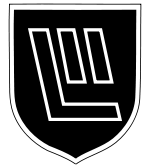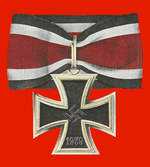Žanis Butkus
| Žanis Butkus | |
|---|---|
 Žanis Butkus | |
| Born |
29 July 1906 Dobele District , Latvia |
| Died |
15 May 1999 (aged 92) Palmer, United States |
| Allegiance |
Latvia Nazi Germany |
| Service/branch |
|
| Years of service |
1927-1929 1942 - 1945 |
| Rank | Hauptsturmführer |
| Unit | 19th Waffen Grenadier Division of the SS (2nd Latvian) |
| Battles/wars | World War II |
| Awards |
Knight's Cross of the Iron Cross Iron Cross I Class Iron Cross II Class German Cross in Gold Close Combat Clasp in Silver Infantry Assault Badge in Silver Eastern Front Medal |
Žanis Butkus (July 29, 1906 – May 15, 1999) was a Latvian Hauptsturmführer (Captain) in the Waffen SS during World War II. Butkus was awarded the Knight's Cross of the Iron Cross by Nazi Germany during World War II.
Early life
Žanis Butkus was born on 29 July 1906, in Augstkalne, Latvia to Fricis and Anna Butkus. After leaving school, he worked on his parents farm. He joined the Latvian Army in 1927 and remained in the military until 1929. Butkus was renowned for his shooting abilities, as he won numerous championships throughout Latvia and the Baltic region. In 1932 he married a Latvian girl, Velta, with whom he had four daughters, Ulla, Inta, Mirdza and Marga. Ulla and Inta emigrated to the United States, while Marga and Mirdza remained in Latvia.
World War II
In 1941, after the Red Army's occupation of Latvia his wife and daughter were deported to Siberia. Butkus joined the national partisans to fight against the Soviet forces until the Germans invaded the territory of Latvia.
In August 1943 on the Volchov Front, Butkus led an assault team into the Soviet lines and proceeded to capture a string of bunkers, without suffering a single casualty. His force soon returned to the German lines with numerous prisoners and a substantial amount of equipment. Butkus was given a commission on the spot and later having taken part in 59 close combat engagements, Butkus was awarded the Knight's Cross.
He survived the war and died on 15 May 1999 in Palmer, Alaska.
Miscellaneous
The Latvian Legion's attachment to the SS, unit designations and ranks were considered a formality. Latvian and Estonian soldiers regardless of whether they volunteered or were drafted, were not members of the Nazi party.
In 1949-50, United States Displaced Persons Commission investigated the Estonian and Latvian SS and found these military units to be neither criminal nor Nazi collaborators. On 12 September 1950, Harry N. Rosenfield, the United Nations Refugee Relief Association commissioner, wrote to Jūlijs Feldmanis, Latvia's chargé d'affaires in Washington, saying that "the Waffen-SS units of the Baltic States (the Baltic Legions) are to be seen as units that stood apart and were different from the German SS in terms of goals, ideologies, operations and constitution, and the Commission does not, therefore, consider them to be a movement that is hostile to the government of the United States under Section 13 of the Displaced Persons Act, as amended."
Awards
- German Cross in Gold on 28 June 1944 as Legion-Untersturmführer in the 10./SS-Freiwilligen-Grenadier-Regiment 43[1]
- Knight's Cross of the Iron Cross on 21 September 1944 as Waffen-Hauptsturmführer and leader of the 10./SS-Feld-Ersatz-Bataillon 19[2][Note 1]
Notes
Further reading
- Citations
- Bibliography
- Fellgiebel, Walther-Peer (2000). Die Träger des Ritterkreuzes des Eisernen Kreuzes 1939–1945 – Die Inhaber der höchsten Auszeichnung des Zweiten Weltkrieges aller Wehrmachtteile [The Bearers of the Knight's Cross of the Iron Cross 1939–1945 — The Owners of the Highest Award of the Second World War of all Wehrmacht Branches] (in German). Friedberg, Germany: Podzun-Pallas. ISBN 978-3-7909-0284-6.
- Mitcham, Samuel W (2007). Retreat to the Reich : the German defeat in France, 1944. Mechanicsburg, PA: Stackpole Books. ISBN 978-0-8117-3384-7.
- Henschler Henri & Fay Will, Armor Battles of the Waffen-SS, 1943-45 Stackpole Books, 2003. ISBN 0-8117-2905-2
- Mitcham Samuel, The German Defeat in the East, 1944-45,Stackpole Books, 2007. ISBN 0-8117-3371-8
- Patzwall, Klaus D.; Scherzer, Veit (2001). Das Deutsche Kreuz 1941 – 1945 Geschichte und Inhaber Band II [The German Cross 1941 – 1945 History and Recipients Volume 2] (in German). Norderstedt, Germany: Verlag Klaus D. Patzwall. ISBN 978-3-931533-45-8.
- Scherzer, Veit (2007). Die Ritterkreuzträger 1939–1945 Die Inhaber des Ritterkreuzes des Eisernen Kreuzes 1939 von Heer, Luftwaffe, Kriegsmarine, Waffen-SS, Volkssturm sowie mit Deutschland verbündeter Streitkräfte nach den Unterlagen des Bundesarchives [The Knight's Cross Bearers 1939–1945 The Holders of the Knight's Cross of the Iron Cross 1939 by Army, Air Force, Navy, Waffen-SS, Volkssturm and Allied Forces with Germany According to the Documents of the Federal Archives] (in German). Jena, Germany: Scherzers Miltaer-Verlag. ISBN 978-3-938845-17-2.
| ||||||||||||||||||||||||||||
| ||||||||||
|


